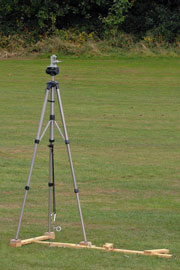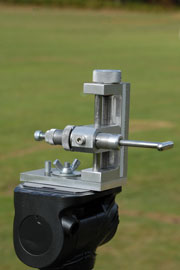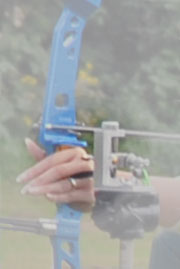An Introduction to Vision-Impaired Archery
It probably is not everybody's idea of wisdom to give a powerful modern bow and arrows to someone who either has limited vision, or worse still is totally blind! And then expect them to launch those arrows at 200 f.p.s. and hit a target? In fact, in the hands of an experienced, vision-impaired (VI) archer the results can put some full-sighted archers to shame.
VI Archery in the UK
To be eligible to participate as a VI archer, you must be registered as blind or partially-sighted and hold a sight classification certificate with British Blind Sports. For archery there are four sight classifications, dependent mostly on visual acuity (i.e. if you have any significant vision, how distinctly can you see objects).
Indoors, VI archers shoot exactly the same rounds as everybody else, but outdoors there are significant differences. Some VI archers may shoot the normal outdoor archery rounds, but with minor changes to allow them to take part with a little less inconvenience; however for the most part they will shoot the "Burntwood" rounds. For each normal archery round, there is an equivalent Burntwood round to allow VI archers to shoot alongside their full-sighted colleagues.
The Burntwood rounds are all set at a single distance - 30 metres; the different distances that occur in "normal" archery rounds are simulated by differing sizes of target face. Simply put, while normal archery rounds usually start at a long distance and the targets are periodically brought closer, the equivalent Burntwood round starts with a small target face, which is changed to a larger face to simulate shorter distances (doubling the diameter of the target is equivalent to halving the distance).
The next issue is aiming. Well, all archers aim in exactly the same way, using alignment to the target. However a full-sighted archer can check their alignment by looking to the target and by the use of a bow sight, neither of which options are open to most VI archers, so they use tactile equivalents.
The first part is the foot locator, a wooden frame which is built to fit the individual's stance. By resting their feet against the wooden frame, the archer knows that they are always standing in the same position each time they come up to the shooting line. Attached to this frame is another to take the feet of a tripod, on top of which (instead of a camera) is a tactile sight. The tactile sight normally consists of an adjustable, spring-loaded bar that touches some part of the back of the archer's bow hand when at full-draw; then, just as with a conventional bow-sight it can be adjusted up, down, left or right to fine-tune their aim and home in on the gold.
 Ken Bearman.
Ken Bearman.
 Ken Bearman.
Ken Bearman.
 Ken Bearman.
Ken Bearman.
The last part of the equation is knowing where the arrows land and adjusting aim accordingly. This is done with the help of a "spotter", an assistant who helps set up the tactile sight and keeps an eye out for safety issues. However their most obvious purpose is to check where arrows land and tell the archer (using the scoring zone and clock-face position); under some circumstances they can help adjust the tactile sight, but this is mostly going to be done by the archer. The spotter will also go to the target to score the arrows and bring them back.
OK, well that's what it says about the spotter in the rules and it gives a very "functional" understanding of this role! However, in practice VI archery is a team event - the archer and spotter work together and there has to be a lot of trust between them; while there are limitations on what the spotter can say and do while the archer is on the shooting line, their role s the kind of help and encouragement that a coach would be expected to give at an international event. The name "spotter" hardly does justice to the role.
Interestingly, the Burntwood round is now also used for some juniors and beginners, because this lets them shoot an equivalent of the full adult rounds without needing the higher poundage bows to reach the longer distances.
International VI Archery
For international competition there are so few VI archers that it is not practical to have as many sight categories as here in the UK - there would only be one or two archers in each! So the current international rules are that all VI archers shoot in one category and must wear a blindfold for shooting so it levels everyone out.
An additional issue is that different countries have differing sight categories and rules for VI archery, so there is no worldwide standard to use. So while other forms of disability archery are include file="/county/county-menu.html"-->d in the Paralympics, VI archery currently is not. The International Paralympic Committee (IPC) has accepted it, but the rules are still being sorted out and the aim is currently for it to become a Paralympic event in time for the 2016 games.
More Details
This is just an introduction to Vision Impaired Archery and no attempt has been made here to go into a lot of detail about the rules, rounds and equipment. If you are interested in the subject and want to find out more, then the following organisations will be able to help:





